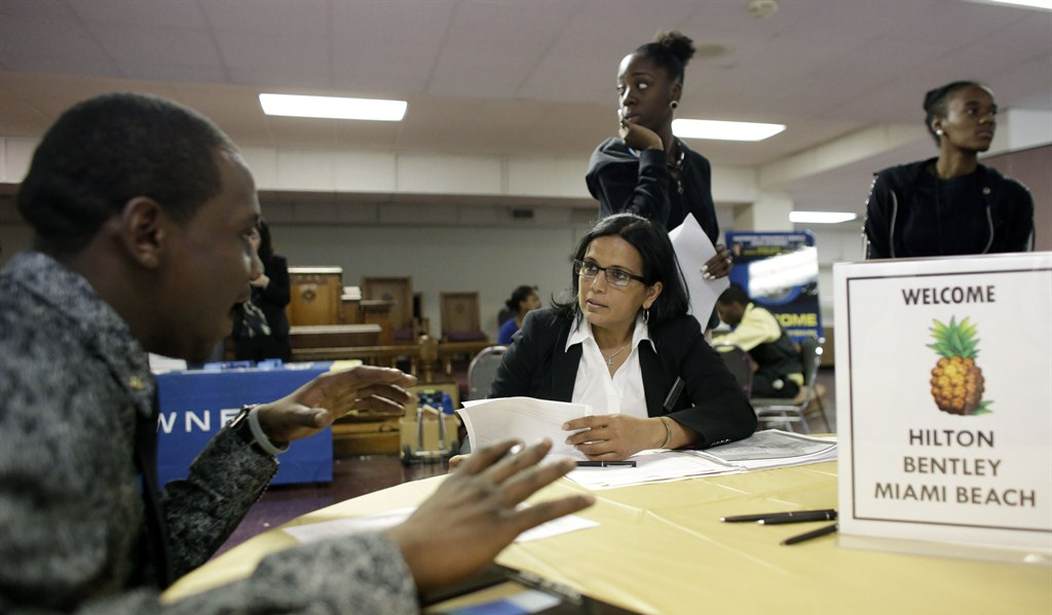Friday, the Labor Department is expected to report the economy added 247,000 jobs in March down from 295,000 in February and 324,000 during the fourth quarter.
Wages, for all but the most skilled professionals, continue to advance only slowly, and going forward good paying jobs and pay raises will likely be even scarcer for struggling middle and working class Americans.
The headline unemployment rate is down to 5.5 percent, from the recession high of 10, largely because fewer adults are participating in the labor force—for example, the 7 million men ages 25 to 55 that neither have a job nor want one.
Were the same percentage of adults working or seeking work today as when President Obama took office, the unemployment rate would be 9.7 percent.
Here are five reasons jobs and wage growth are likely to be disappointing the balance of 2015 and in 2016.
1. Stronger Dollar and Tepid Consumers
The dollar is up against the euro and yen, making U.S. goods and services more expensive than competing products from Germany and Japan. Along with the impact of falling oil prices on U.S. drilling activity that discourages business investment.
So far consumers have been hesitant to spend the windfall from lower gasoline prices—retail sales have plunged in recent months—and business activity simply will not support adding a lot of new workers.
2. Productivity Growth
In 2014, non-farm private sector output grew 2.9 percent but hours worked increased 3.0 percent—indicating labor productivity growth was near zero.
Recommended
Advances in robotics, logistics and production design should permit productivity to advance at about 2 percent annually. If U.S. companies don’t find ways to use workers more efficiently, they will lose more ground to foreign competitors who do.
Consequently, forecasters such as at Wells Fargo, expect monthly employment gains to trend down to about 215,000 this summer and below 200,000 in 2016, leaving workers with less bargaining power in salary negotiations.
3. Myth of College Graduate Underemployment
Hundreds of thousands of college graduates continue to work in jobs that historically did not require a degree, but many BAs may be well placed as Starbucks baristas.
Tests administered by the Council for Aid to Education indicate 40 percent of recent graduates are not proficient in the basic problem-solving skills normally associated with a college education. Hence they may not be worth much more than $10 or $15 per hour paid to many high school graduates.
4. The Skills Gap
Many businesses complain about difficulties finding workers with the skills they need.
Although the United States has a world leading network of science and engineering colleges, too few Americans are enrolled. Two-year community colleges are not training enough young people for technical workers in high demand, and too many community college students instead are preparing to transfer into four-year college liberal arts programs.
5. Too Many Americans in the Wrong Places
Urban areas have recovered all the jobs lost during the financial crisis and added another 3 percent, whereas employment in rural areas is still down by an equal amount.
Rural workers often lack the skills demanded in better paying service industries centered in cities, like finance, technology and media, and simply can’t afford to relocate to high-cost urban centers for $10 to $15 an hour jobs in restaurants, dry cleaners and health clubs catering to elite service workers.
The balance of this year and next, the U.S. GDP growth will continue to inch along at a 2.5 to 3 percent pace. The economy will reward the top ten-percent of workers in engineering, finance and other elite services, but too many other Americans lack the skills to earn the $25 or $30 an hour needed to sustain a middle class life-style, and live in places where jobs of any kind remain scarce.



















Join the conversation as a VIP Member